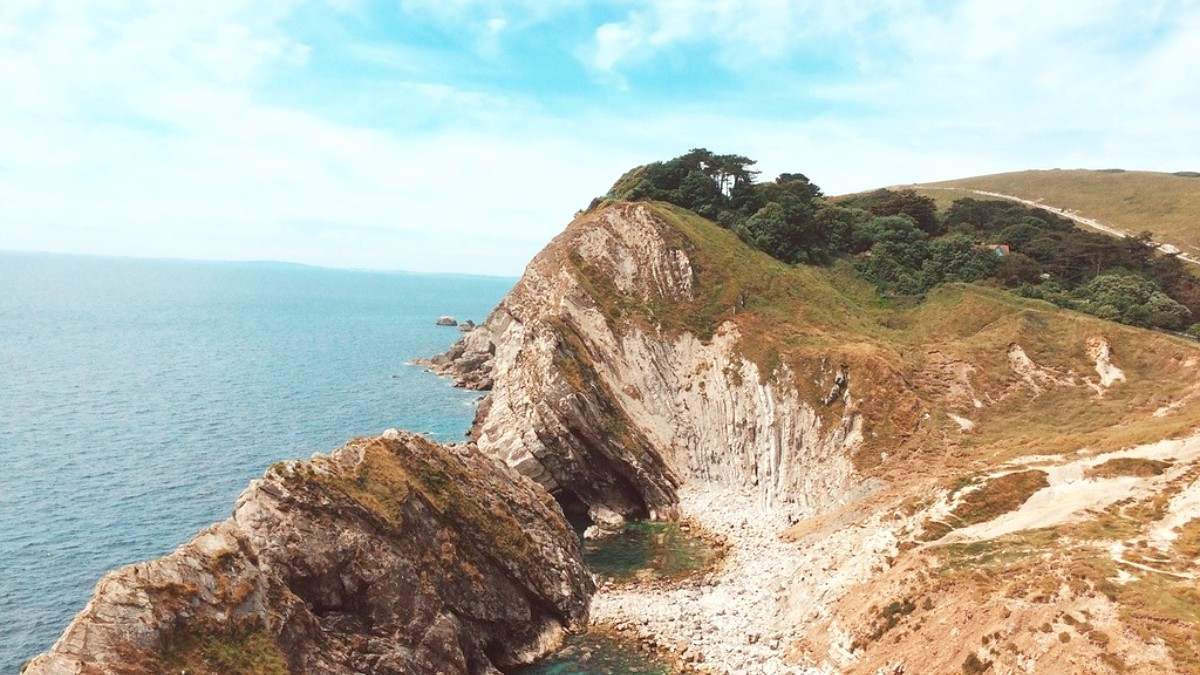
England, UK
The Jurassic Coast is famed for its unique geological formations, sculpted by millennia of natural forces. These sites present a visual journey through 185 million years of Earth's history, showing a continuous sequence of Triassic, Jurassic, and Cretaceous rocks.
Each landmark along the coastline not only presents stunning scenery but also tells a compelling story of ancient environments, changing sea levels, and the powerful processes of erosion and deposition. Visitors witness firsthand the raw beauty and scientific importance of this UNESCO World Heritage Site.
Both sites are immensely popular; plan your visit to avoid peak crowds for a more tranquil experience.
The highest point on the South Coast of England, reaching 191 meters (627 feet). Its distinctive golden sandstone cliff presents panoramic views. The 'golden' color comes from greensand and sandstone layers.
Access via National Trust car parks (paid) and well-marked walking paths from Seatown or Charmouth. The ascent is steep in places. Offers incredible views.
An 18-mile (29-kilometer) long shingle barrier beach stretching from West Bay to the Isle of Portland. Known for its pebbles, graded by size.
Do not attempt to walk the entire length on the shingle; it is extremely tiring. Best enjoyed from viewpoints (e.g., from the clifftops at West Bay or from Portland).
Behind Chesil Beach lies the Fleet Lagoon, an unique brackish water habitat, a significant wildlife habitat for birds.
Explore the human and natural history of the Jurassic Coast in its engaging museums and cultural venues.
Located at Mary Anning's birthplace, this museum presents an immersive look into local history and palaeontology. It features an extensive fossil collection and tells the story of Mary Anning and her discoveries.
Situated directly on Charmouth beach, this center serves as an excellent starting point for fossil hunting. It presents educational exhibits on local geology and fossils.
A privately owned museum boasting a large and impressive collection of local fossils, including a variety of ammonites, ichthyosaurs, and plesiosaurs.
A Victorian fort built to protect Weymouth Harbour. Explore underground passages, learn about military history through interactive exhibits, and enjoy panoramic views.
This local history museum presents insights into Portland's unique heritage, including its famous quarrying industry, maritime history, and literary connections.
Book tickets for many attractions in advance through platforms like GetYourGuide for convenience and to secure your entry.
A dramatic ruin perched on a hill, strategically positioned to guard the Purbeck Hills gap. Over 1000 years of history, served as a royal fortress before its destruction in the 17th century. A National Trust property.
A Neolithic henge monument, later adapted by the Romans into an amphitheatre for public spectacles, including gladiatorial contests. Free access, a significant historical landmark.
The remains of a remarkably well-preserved Roman townhouse, discovered in the 1930s. It presents a glimpse into the domestic life of Roman Durnovaria (Dorchester), featuring preserved mosaic floors.
The Jurassic Coast region is a rich human history, from ancient settlements to medieval strongholds.
Beyond the well-known landmarks, the Jurassic Coast presents numerous natural spaces perfect for exploration and appreciation of its unique ecology.
The extensive network of trails, unique coves, and diverse habitats invite visitors to discover the region's breathtaking natural beauty and significant wildlife. Each location offers a distinct experience of the coast's dynamic landscape.
The coastline's natural features are best experienced through its pathways and unique geological formations.
Unique coastal features provide varied opportunities for exploration and wildlife observation.
The Jurassic Coast's geological formations present unique characteristics at every turn, offering deep insights into Earth's processes.
Beyond geology, the Jurassic Coast is a haven for diverse wildlife, making it a prime destination for nature enthusiasts and photographers.
Seek out these less-frequented but equally rewarding spots for a more intimate experience of the Jurassic Coast.
A poignant glimpse into the past. This village was requisitioned by the military during World War II for training purposes and never returned to civilians. The deserted buildings and church present a preserved snapshot of 1940s rural life.
A quieter, unspoiled shingle beach managed by the National Trust, located between West Bay and Burton Bradstock. It presents tranquility, good views of Chesil Beach, and a chance for a peaceful walk away from larger crowds.
An 18-mile (29-kilometer) long shingle barrier beach stretching from West Bay to the Isle of Portland. This unique geological feature is known for its pebbles.
The dramatic power of the sea breaking on the shingle provides an impressive sight. Do not attempt to walk the entire length on the shingle; it is extremely tiring.
A charming, traditional village on the Isle of Purbeck, presenting a quintessential English rural experience. It features a classic, much-loved pub.
A good base for exploring the eastern end of the coast for those desiring a quieter village atmosphere.
Beyond the main highlights, several other sites contribute to the unique character of the Jurassic Coast and offer rewarding visits.
These diverse spots ensure there is always something new to discover, catering to a range of interests.
Always check opening times for specific attractions like Tyneham Village before visiting, as access can be restricted.
Many coastal walks and cliff paths involve uneven terrain; sturdy footwear is highly recommended for safety and comfort.
Stay well away from cliff edges, as they can be unstable. Be aware of tide times on beaches to avoid getting cut off.